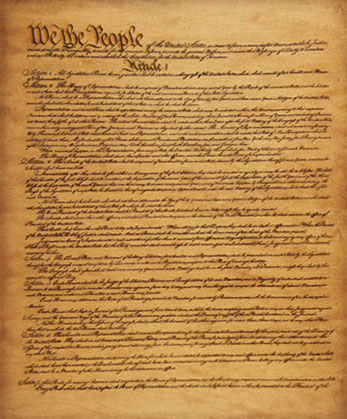Westhampton Beach outside counsel Brian Sokoloff has signed a deal with the East End Eruv Assn. giving it permanent permission to put Jewish religious symbols on 46 telephone poles on public property.
The agreement, which has deep flaws in the opinion of this writer, a resident and registered voter in WHB, has the signatures of nine participants in the EEEA but no signatures of either Mayor Maria Moore or the four other Trustees—Brian Tymann, Rob Rubio, Charles Palmer or Ralph Urban.
 Tymann and Rubio were elected last June 19 on the promise that they would never sign an agreement allowing permanent religious symbols on public property. The other three Trustees have not said how they stand on this issue.
Tymann and Rubio were elected last June 19 on the promise that they would never sign an agreement allowing permanent religious symbols on public property. The other three Trustees have not said how they stand on this issue.
Legality Could Be Questioned
This deal is being done in such a sneaky way that its legality is open to question.
It is on the WHB website today but it is not highlighted. Visitors to the site have to go to “Eruv Litigation” to find it. That has been a very uninformative and incomplete place to go to since it basically has legal decisions but no explanatory essays by law professors who have shown the unconstitutional nature of eruvim. The previous entry on the eruv on the site is dated June 30, 2015. At right is U.S. Constitution.
We have emailed Mayor Moore as follows:
Mayor Moore:
The legal agreements are on the website in the “Eruv Litigation” area and not on the main page. A lot of people will not see this.
Also, neither Mayor Moore nor any of the four other Trustees signed the papers, only Brian Sokoloff, outside counsel. I want to know, as a citizen, taxpayer and registered voter in WHB, how Mayor Moore and the four other Trustees voted on this.
Brian Tymann and Rob Rubio were elected in 2015 on the promise they would never sign an agreement allowing an eruv in WHB.
Nine people signed their names for the EEEA. They are not hiding behind their lawyers. They are Marvin Tenzer, Morris Tuchman, Clinton Greenbaum, Alan Schechter Carol Schechter, Jeffrey Lean, Aleca Lean, Deborah Pollack and Simcha Pollack.
As a citizen, I would like to know how the five Trustees voted on this and why no signatures of any of them are on this legal notice—Tymann, Rubio, Moore, Charles Palmer and Ralph Urban. It’s possible this is an illegal action.
This has been signed by Sokoloff before residents had a chance to read it or discuss it at a town hall meeting; before the WHB election of June 17, and before many residents have returned for the summer. That is three strikes against this action.
Religious Nature of Eruv Denied
The agreement falsely says that the “settlement of this case is not a recognition or endorsement of any religion or religious boundary by the Village of WHB” when that is exactly what it is.
A map of the WHB claimed eruv is in about one million copies of the New York Times of May 30 as depicted on the Hampton Synagogue website.. That demolishes claims in court documents and the Southampton Press that the claimed WHB eruv is somehow “invisible” or “hard to see” or that the entire nation including residents in WHB somehow does not know the religious nature of eruvim.
The WHB agreement does not make the claim that was in the Southampton agreement with EEEA that "erection of the eruv is not an unconstitutional establishment of religion under the First Amendment." That false claim was in the decision by the U.S. Court of Appeals for the Second Circuit in its summary order dated Jan. 6, 2015, revised as an opinion dated Feb. 11, 2015.
The problem is that the eruv is an unconstitutional establishment of religion. That is why that sentence does not appear in the WHB settlement. Calling eruvim Constitutional defies a number of court orders including the 2005 decision in McCreary County vs. ACLU of Kentucky that barred permanent religious displays on public property. Temporary displays were allowed.
Also, the “reasonable observer” that is the lynchpin of decisions that allow an eruv is a concept from the 1971 Supreme Court “Lemon” decision. Retired Justice Sandra O’Connor said in 1995 that a reasonable observer is now “more informed than the casual passerby.”
Of course they are! Near universal access to the web came in about 20 years ago and wiped out all claims that the public can’t see eruvim and if they could they would not know what they mean. Even schoolchildren know what is going on in WHB.
This is a black day for the Village.
Sincerely,
Jack O’Dwyer


 Husch Blackwell Strategies has added FleishmanHillard alum Michael Slatin as a principal in its public affairs group.
Husch Blackwell Strategies has added FleishmanHillard alum Michael Slatin as a principal in its public affairs group. Rory Cooper, a veteran Republican operative and policy specialist, has joined Teneo’s Washington office as senior managing director in its strategy & communications practice.
Rory Cooper, a veteran Republican operative and policy specialist, has joined Teneo’s Washington office as senior managing director in its strategy & communications practice. Brian Fallon, who served as national press secretary for Hillary Clinton’s 2016 presidential run, is signing on next month as Vice President’s Kamala Harris’ campaign communications director.
Brian Fallon, who served as national press secretary for Hillary Clinton’s 2016 presidential run, is signing on next month as Vice President’s Kamala Harris’ campaign communications director. TikTok is nothing more than a Chinese propaganda tool that poses “a grave threat to America’s national security and, in particular, impressionable children and young adults,” say two Congressmen who want the platform registered as a foreign agent.
TikTok is nothing more than a Chinese propaganda tool that poses “a grave threat to America’s national security and, in particular, impressionable children and young adults,” say two Congressmen who want the platform registered as a foreign agent. Public Strategies Washington has added Abbie Sorrendino, a former aide to now Senate Majority Leader Chuck Schumer.
Public Strategies Washington has added Abbie Sorrendino, a former aide to now Senate Majority Leader Chuck Schumer.


 Have a comment? Send it to
Have a comment? Send it to 
No comments have been submitted for this story yet.